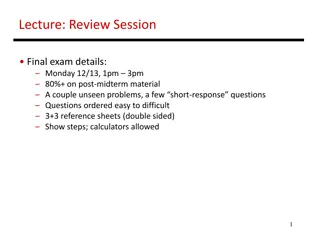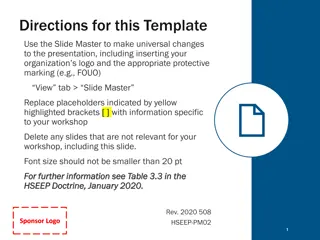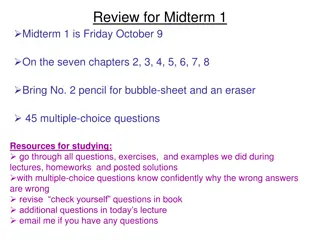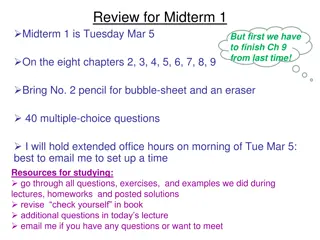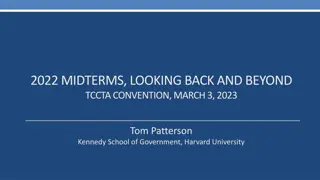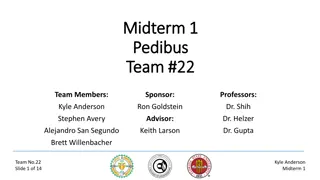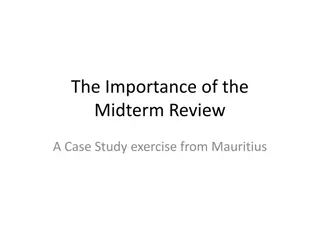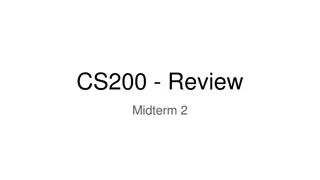Midterm I review
Dive into the key concepts of Finite Automata including Deterministic and Non-deterministic Finite Automata, their definitions, differences, construction checklists, NFA to DFA conversion techniques, and more. Explore syllabus topics on formal proofs, regular expressions, and the pumping lemma for regular languages. Test your knowledge with closed-book, closed-notes exams to showcase understanding of DFA, NFA, and regular languages.
Download Presentation

Please find below an Image/Link to download the presentation.
The content on the website is provided AS IS for your information and personal use only. It may not be sold, licensed, or shared on other websites without obtaining consent from the author.If you encounter any issues during the download, it is possible that the publisher has removed the file from their server.
You are allowed to download the files provided on this website for personal or commercial use, subject to the condition that they are used lawfully. All files are the property of their respective owners.
The content on the website is provided AS IS for your information and personal use only. It may not be sold, licensed, or shared on other websites without obtaining consent from the author.
E N D
Presentation Transcript
Midterm I review Reading: Chapters 1-4 1
Test Details In class, Wednesday, Feb. 25, 2015 3:10pm-4pm Comprehensive Closed book, closed notes 2
Syllabus Formal proofs Finite Automata NFA, DFA, -NFA Regular expressions Regular languages & properties Pumping lemma for regular languages 3
Finite Automata Deterministic Finite Automata (DFA) The machine can exist in only one state at any given time Non-deterministic Finite Automata (NFA) The machine can exist in multiple states at the same time -NFA is an NFA that allows -transitions What are their differences? 4
Deterministic Finite Automata A DFA is defined by the 5-tuple: {Q, , q0,F, } Two ways to define: State-diagram State-transition table (preferred) DFA construction checklist: Associate states with their meanings Capture all possible combinations/input scenarios break into cases & subcases wherever possible Are outgoing transitions defined for every symbol from every state? Are final/accepting states marked? Possibly, dead/error-states will have to be included depending on the design. 5
Non-deterministic Finite Automata A NFA is defined by the 5-tuple: {Q, , q0,F, } Two ways to represent: State-diagram State-transition table (preferred) NFA construction checklist: Has at least one nondeterministic transition Capture only valid input transitions Can ignore invalid input symbol transitions (paths will die implicitly) Outgoing transitions defined only for valid symbols from every state Are final/accepting states marked? 6
NFA to DFA conversion Checklist for NFA to DFA conversion Two approaches: Enumerate all possible subsets, or Use lazy construction strategy (to save time) Introduce subset states only as needed In your solutions, use the lazy construction procedure by default unless specified otherwise. Any subset containing an accepting state is also accepting in the DFA Have you made a special entry for , the empty subset? This will correspond to the dead/error state 7
-NFA to DFA conversion Checklist for -NFA to DFA conversion First take ECLOSE(start state) New start state = ECLOSE(start state) Remember: ECLOSE(q) include q Then convert to DFA: Use lazy construction strategy for introducing subset states only as needed (same as NFA to DFA), but Only difference : take ECLOSE after transitions and also include those states in the subset corresponding to your destination state. E.g., if q_i goes to {q_j, q_k}, then your subset must be: ECLOSE(q_j) U ECLOSE(q_k) Again, check for a special entry for if needed 8
Regular Expressions A way to express accepting patterns Operators for Reg. Exp. (E), L(E+F), L(EF), L(E*).. Reg. Language Reg. Exp. (checklist): Capture all cases of valid input strings Express each case by a reg. exp. Combine all of them using the + operator Pay attention to operator precedence Try to reuse previously built regular expressions wherever possible 9
Regular Expressions DFA to Regular expression Enumerate all paths from start to every final state Generate regular expression for each segment, and concatenate Combine the reg. exp. for all each path using the + operator Reg. Expression to -NFA conversion Inside-to-outside construction Start making states for every atomic unit of RE Combine using: concatenation, + and * operators as appropriate For connecting adjacent parts, use -transitions Remember to note down final states 10
Regular Expressions Algebraic laws Commutative Associative Distributive Identity Annihiliator Idempotent Involving Kleene closures (* operator) 11
English description of lang. Finite automata english description Regular expression english description English description should be similar to how we have been describing languages in class E.g., languages of strings over {a,b} that end in b; or Languages of binary strings that have 0 in its even position, etc. Thumbrule: the simpler the description is, the better. However, make sure that the description should accurately capture the language. 12
Pumping Lemma Purpose: Regular or not? Verification technique Steps/Checklist for Pumping Lemma (in order): Let N pumping lemma constant Choose a template string w in L, such that |w| N. (Note: the string you choose should depend on N. And the choice of your w will affect the rest of the proof. So select w judiciously. Generally, a simple choice of w would be a good starting point. But if that doesn t work, then go for others.) Now w should satisfy P/L, and therefore, all three conditions of the lemma. Specifically, using conditions |xy| N and y , try to conclude something about the property of the xy part and y part separately. Next, use one of these two below strategies to arrive at the conclusion of xykz L (for some value of k): Pump down (k=0) Pump up (k >= 2) Note: arriving at a contradiction using either pumping up OR down is sufficient. No need to show both. 1) 2) 3) 4) 13
Working out pumping lemma based proofs as a 2-player game: Steps (think of this 2-party game): Good guy (us) Bad guy (someone else) Claims L is regular Builds w using N (without assuming any particular value of N) => Knows N and has the freedom to choose any value of N 1 Tries to break the third condition of P/L without assuming any particular {x,y,z} split this is done by first pumping down (k=0) if that does not work, then try pumping up (k 2) Comes up with {x,y,z} combination, s.t. w=xyz (again, has the freedom to choose any xyz split, but meeting the two conditions of P/L: i.e., |xy| N and y ) 14
GOOD LUCK! 15
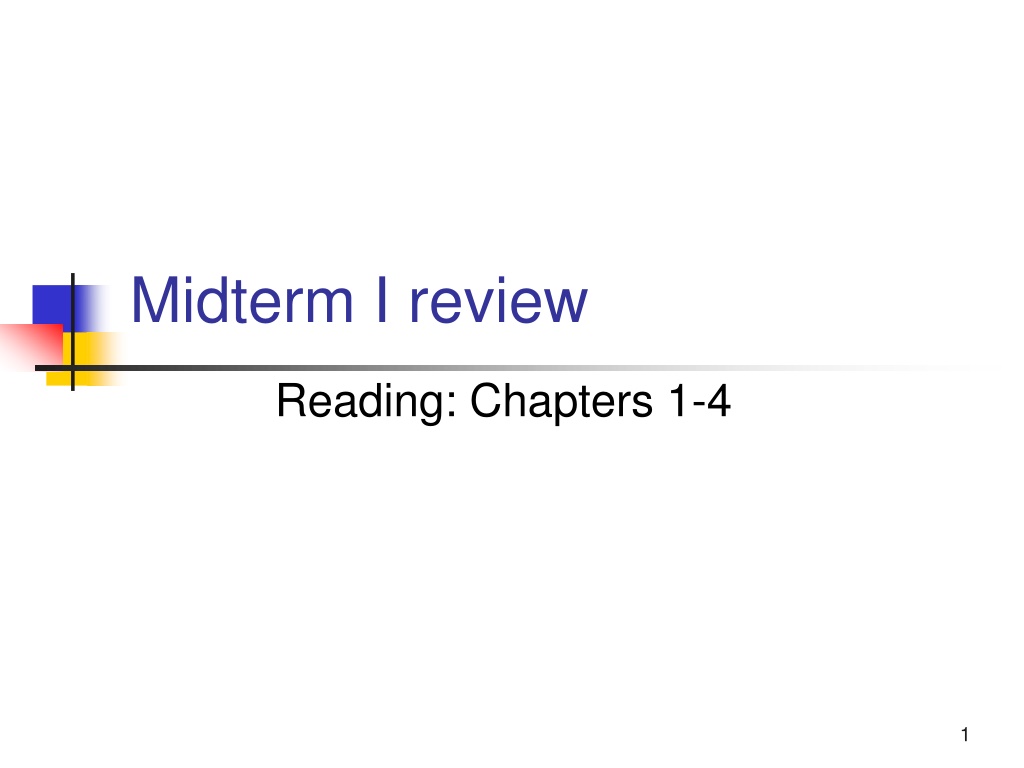
 undefined
undefined





















